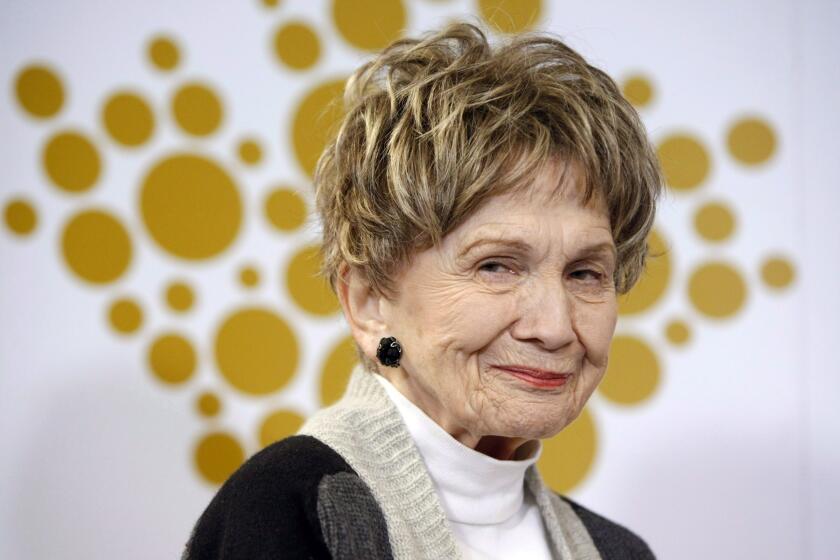Robert McCloskey, 89; Wrote Children’s Classics
Robert McCloskey, the first children’s book author and illustrator to win two Caldecott Medals, one of the highest honors given for children’s literature, has died. He was 89.
McCloskey, who won the prizes in 1941 for “Make Way for Ducklings” and in 1957 for “Time of Wonder,” died Monday at home in Deer Isle, Maine. He had been in failing health for some time.
Of the eight books he wrote and illustrated, the story of Mrs. Mallard and her baby ducks as told in “Make Way for Ducklings” is his best known.
The idea came to him when he was working as a muralist in Boston in the late 1930s and noticed a family of ducks waddling along the city street. His story is about how the family moves to the public garden and takes up residence at the pond. To get a closer look at his subjects, McCloskey bought four mallards, let them loose in his apartment and put them in the bathtub to watch them swim.
The book was officially recognized by the city of Boston in 1987 when artist Nancy Schoen made a sculpted version of McCloskey’s ducks for the public garden and dedicated the work to him. By then, Boston’s annual Duckling Parade, in which children dress like their favorite character from the book, was 7 years old.
Former First Lady Barbara Bush was instrumental in getting the book translated into Russian in 1991. She presented a replica of the Boston bronze to Raisa Gorbachev, wife of the Russian president, to be installed in a Moscow park.
McCloskey discovered his love for art when he took up printmaking, engraving and woodcutting in high school in his hometown of Hamilton, Ohio. In his senior year, he won an art contest sponsored by Scholastic, the magazine for young students. His prize was a scholarship to Boston’s Vesper George School of Art in 1932.
“After that, I tackled everything I could in drawing and painting, thinking I might become an illustrator of children’s books some day,” he told the Bangor Daily News in July 1996. “I had no thoughts of being a writer.”
McCloskey finished art school in Boston and moved to New York City, where he entered the National Academy of Design in 1936. He spent summers taking art classes in Provincetown, Mass. After graduation, he found jobs as a muralist in Boston and at home in Hamilton.
He worked steadily at his paintings, but sold hardly any. Although he was struggling financially, he won the Prix de Rome in 1939 to further his art education in Italy. World War II interrupted his studies, and McCloskey served in the Army from 1942 to 1945. He finally went to Italy to study in 1949.
His artistic talent came as a surprise to his parents, who had expected him to be a musician. As a boy, he played the piano, harmonica, oboe and percussion instruments. He thought about becoming an inventor and built electronic gadgets, including a turntable for the family Christmas tree and a cotton candy machine.
Both music and tinkering found their place in McCloskey’s books. Several characters in his early stories are based on his life or the lives of other boys he knew.
“Lentil” (1940) and “Homer Price” (1943) feature young, energetic boys, curious about the world around them. Lentil plays the harmonica; Homer loves gadgets. Reviewers compared the characters to Tom Sawyer, and remarked that McCloskey’s illustrations of quaint, all-American hometowns recalled the art of Norman Rockwell.
McCloskey’s love of music led to stories sprinkled with words that imitate sounds -- the “clackety-BANG” of a motorboat, for one. He once said that the sound of blueberries dropping into a bucket, “ker-PLUNK,” inspired “Blueberries for Sal” (1948). One of his most popular books, it is about a girl and her mother who meet a bear and her cub while they are picking berries.
McCloskey also illustrated 10 books by other authors, including “Journey Cake, Ho!” by Ruth Sawyer, who was the mother of Margaret Durand, a children’s librarian whom McCloskey married in 1940.
The couple had two children, Sarah and Jane, and over the years the family lived in several of the small towns north of New York City but spent summers in Maine. In 1946, McCloskey bought Scott Island, off Deer Isle, Maine.
From then on, he found most of the subjects for his stories close to home. Readers got to know the McCloskey daughters, (Sarah’s nickname was Sal) and the local sites -- Maine lobster boats, quaint shops, the town gas station -- in stories such as “Blueberries for Sal,” “One Morning in Maine” (1952) and “Time of Wonder” (1957).
Set in Maine, “Time of Wonder” describes the beauty of the area during summer and how it is threatened when a hurricane blows toward Penobscot Bay. McCloskey was awarded his second Caldecott Medal for the work.
After his daughters were grown, along with several generations of children who were raised on his storybooks, parents continued to bring their sons and daughters to visit the corner of Maine they first discovered as children reading McCloskey’s books.
He never considered himself an author. “I am primarily an artist, incidentally a writer,” he told the Bangor Daily News in 1996.
In an autobiographical sketch for the Junior Book of Authors, McCloskey said it took him two or three years to go from an idea to a book. He did extensive research and made dozens of sketches and drawings before he was ready to put art and story together.
Throughout McCloskey’s career, reviewers, teachers and children’s librarians praised his stories for their gentle humor, authentic detail and unfailingly kind portrayal of characters. “Each of his books is a gem and each accomplishes a different goal, though they are alike in their innocent, homey humor and the best kind of patriotism,” Anita Silvey wrote in “Children’s Books and Their Creators” (1995).
Many of McCloskey’s books were adapted as films in the 1950s and ‘60s. Several were accompanied by a teacher’s guide. After McCloskey gave up illustrating and writing about 1970, he continued to win awards for his contributions to children’s literature. In April 2000, he was named a Living Legend by the Library of Congress.
McCloskey’s wife died in 1990 and he became more and more of a recluse. Tim Clark, a fan who was writing an article about his love for McCloskey’s books for Yankee magazine in 1999, phoned the artist. “I asked if life on the islands is still as simple and happy as it was 50 years ago,” Clark recalled. “He asked for a week to think about it. When I called him back, he said he’d rather not say.”
McCloskey is survived by his two daughters and two grandchildren.
More to Read
Sign up for our Book Club newsletter
Get the latest news, events and more from the Los Angeles Times Book Club, and help us get L.A. reading and talking.
You may occasionally receive promotional content from the Los Angeles Times.






